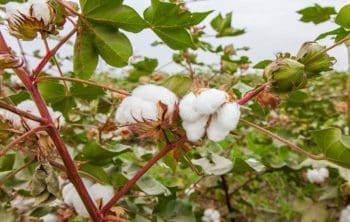Textile Exchange’s 2019 Organic Cotton Market report has revealed that 2017/2018 saw 56 per cent growth in global organic cotton production with India, China, and Kyrgyzstan as biggest contributors. Latest figures show that global production of organic cotton fibre reached 180,971 metric tons (MT) in 2017/2018 – the highest volume seen since 2009/2010.
Textile Exchange, the only organisation to collect and report on global organic cotton production data, estimates that this growth is set to continue, with India, Tanzania, Turkey, Kyrgyzstan and China all having significant areas of cotton-growing land in transition to organic.
The number of facilities certified to voluntary organic standards is also on the rise, with facilities certified to the Global Organic Textile Standard and Textile Exchange’s Organic Content Standard growing by 15 and 16 per cent respectively.
Cotton is grown organically in 19 countries around the world and the Organic Cotton Market Report reveals that 98 per cent of the production stems from just 7 of these: India (47 per cent), China (21 per cent), Kyrgyzstan (12 per cent), Tukey (6 per cent), Tajikistan (5 per cent), the United States (3 per cent), and Tanzania (3 per cent).
Organic cotton now makes up 0.7 per cent of total cotton production globally. In 2017/2018, the fibre was planted on a total of 356,131 hectares (ha), with an additional 44,394 ha in transition to organic. Production was carried out by a total of 182,876 farmers, the majority of whom were smallholders growing organic cotton in rotation with other crops.
An interesting trend, identified in India this reporting year, was that organic cotton farmers increased the proportion of certified land used to grow cotton (as opposed to other organic crops) from 45 to 70 per cent, which contributes in part to the 44 per cent growth seen in India’s production.
Farmer access to cotton seed that has not been genetically modified (GM) remains a huge obstacle for organic farmers, particularly in countries such as China and India where GM cotton dominates the cotton landscape. The report highlights some of the great progress being made in this area and includes an urgent call to action for added investment in non-GM seed programmes, as well as for companies to develop their own organic cotton safeguarding programmes.
With the rise in awareness of the climate emergency that our planet is facing, Textile Exchange sees organic cotton as a key component to the myriad of solutions that are urgently needed.
“Organic cotton, alongside other organic land-based fibres, must be part of the future. Organic cotton farmers, organisations, companies, and other supporters represented in this report provide a guiding light. We are proud to bring you our 2019 Organic Cotton Market Report and are committed to leveraging organic cotton as a market-driven solution to industry transformation and meeting the global goals,” said Liesl Truscott, director of European & Materials Strategy at Textile Exchange.
“Organic production of cotton is the tip of the spear that has been driving change within the sector. It establishes a direction of travel for all of us, starting with regenerative soil practices,” said Textile Exchange’s managing director, La Rhea Pepper.

